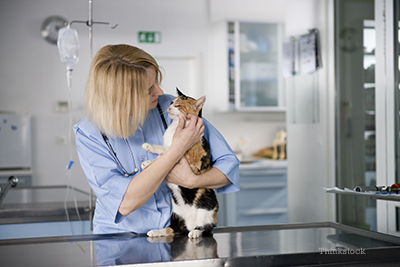Cats are masters at concealing their illnesses. The signs of most cat health problems are very subtle in the beginning. Diabetes mellitus, once referred to as “sugar diabetes,” is no exception. Because cats are private and secretive some of the signs of diabetes may go unnoticed by their guardians.
 Many of the signs of diabetes are non-specific. Subtle increases in water intake and urine output may go undetected, especially in outdoor cats1.
Many of the signs of diabetes are non-specific. Subtle increases in water intake and urine output may go undetected, especially in outdoor cats1.
Cats and people are similar in that we may miss the early signs. Many people have undiagnosed, subtle diabetes that, left uncontrolled, will progress to serious diseases. Cats are similar. A mild elevated blood sugar level may be insignificant or may be a precursor for full-blown diabetes.
How will my veterinarian test my cat for diabetes?
While an elevated fasting blood glucose level is strong evidence of diabetes, even in people, repeated fasting tests may be needed to confirm a diagnosis of diabetes–that test is called a glucose tolerance test. In cats, obtaining an accurate blood glucose level can be a challenge. The simple act of collecting blood from a cat can cause them to become agitated and result in an impact on blood sugar levels. Detection of glucose in the urine significantly increases the likelihood that diabetes is present, but not always. Blood sugar levels can be elevated to twice normal before glucose is detected in the urine1.
Many cat owners are not familiar with another blood test called fructosamine--a test that measures a byproduct of glucose metabolism rather than glucose itself. It is of particular value in cats. A serum fructosamine level is used to confirm the diagnosis of diabetes in most feline cases. Serum fructosamine concentrations are probably the most reliable and easiest way of evaluating your cat’s response to insulin therapy and are evaluated in conjunction with blood glucose curves and recheck examinations. It is a simple test and some veterinarians include this as part of their routine evaluation of cats they consider to be at risk.
Advantages of measuring fructosamine are that it:
- Distinguishes hyperglycemic, non-diabetic animals from diabetics with chronic hyperglycemia
- Is not influenced by stress hyperglycemia
- Is of value in confirming the diagnosis of diabetes and monitoring the response to treatment.
Diabetes can present real challenges in the initial diagnosis and management, but cat owners and veterinarians are interested in the same thing--keeping your cat healthy.
If you have any questions or concerns, you should always visit or call your veterinarian -- they are your best resource to ensure the health and well-being of your pets.
Resources:
1. The Signs, Diagnosis & Types of Diabetes Mellitus in Cats, Pet Education.com http://www.peteducation.com/article.cfm?c=1+2130&aid=199
